
THE PRISON OFFICIAL'S directions to the state's super maximum-security
lockup, Special Management Unit II, went something like this:
Take Arizona Highway 79 north of Tucson about one hour. In Florence, take a right on Butte Avenue at the Blue Mist Motel; that's where Robert Moorman strangled and stabbed his mother. "He's here at SMU II," the official
said portentously.
In time, Moorman will receive a lethal injection for the early
'80s incident that included chopping his mother's body into pieces
and disposing of them in dumpsters throughout Florence. But with
the exception of the 111 Death Row inmates incarcerated in SMU
II for their crimes, many of the remaining 621 prisoners just
"couldn't run on the yard," as one corrections officer
puts it.
"In fact, we've had individuals who come in for DWI and
are serving a four-month sentence and are such a management problem
that they end up in SMU II," testified prison Director Terry
Stewart in a three-day hearing last year before a federal appeals
court.
 The unit is the most onerous place to serve time in the state
prison system.
The unit is the most onerous place to serve time in the state
prison system.
With a security clearance off Butte, the more than two-mile drive
east to SMU II is past scraped Sonoran Desert with sun gleaming
brightly off of quonset huts and signs reading "No parking,
standing, stopping, or loitering on this road." The pavement
crosses an irrigation ditch and the road eventually forks and
dead ends at SMU II. If everything inside the tangled prison bureaucracy
works as planned, at least one-fourth of the prison population
inside the unit will not see the outside of the supermax until
they walk freely on your streets. Fourteen percent will leave
the Department of Corrections in a body bag.
Yet somehow, the town of Florence seems to suffer from prison
amnesia. Chamber of Commerce boosters avoid discussing the three
prisons in the county, much less the two supermaxes in the Arizona
State Prison-Eyman Complex, where the state confines some 1,720
inmates in complete lockdown, a population exceeding that of Florence
itself.
The austere life inside SMU II is the product of many things.
U.S. Supreme Court decisions dating back to 1974 ensure that prisons
stay isolated and unknown, allowing the public to ignore what
happens to a criminal after sentencing.
And, as politicians have pumped up their anti-crime rhetoric,
state DOC administrators have responded exactly as they see fit--their
taxpayer-supported $535 million annual budget surpassed, at last
count, by only three other states in the percentage of the state's
cash pie.
Three years ago, Director Stewart told The Arizona Republic
that one of the best uses of prison funds is in building places
like SMU II. Not a surprising perspective given that Arizona has
been at the vanguard of the country's correctional zeitgeist in
stripping away inmate privileges. The long-term lockdown imposed
on prisoners inside the state's two supermaxes is, figuratively
speaking, the DOC-sanctioned version of a straitjacket.
 Yet with hard time getting tougher, Arizona still has a 39.5
percent prisoner recidivism rate. With mandatory sentencing and
fewer early releases, the state's prison population has ballooned
more than nine-fold in 20 years, from 2,833 prisoners in 1978
to 25,600 at the end of '98.
Yet with hard time getting tougher, Arizona still has a 39.5
percent prisoner recidivism rate. With mandatory sentencing and
fewer early releases, the state's prison population has ballooned
more than nine-fold in 20 years, from 2,833 prisoners in 1978
to 25,600 at the end of '98.
This, along with overcrowding, increased internal violence and
a chronic shortage of low-paid correctional officers, has led
prison officials to search for new methods of managing prisoners
without sacrificing security.
Corrections professionals in Arizona and other states seem to
have found their answer, at least in part, by using high-tech
prisons to place inmates in cold storage--the new incentive for
good behavior. Long-haul stints in solitary are so common today
that more than 34 states have at least one supermax. Fifty-seven
such New Alcatrazes, as they're sometimes called, contain nearly
10 percent of all prisoners in the country. Arizona has two.
Experts say that mentally ill prisoners end up in long-term solitary
as a result of repeated and often insignificant rule violations
stemming from their mental illness. It's estimated that 20 percent
of the general prison population is mentally ill, and experts
say the solitary units contain at least twice that. Also, two-thirds
of the supermax inmates are minorities.
Craig Haney, a national expert on the psychological effects of
long-term solitary prison incarceration, says the three-year-old
Arizona supermax is one that often comes up in conversation as
one of the most "severe" units in the country. Even
in the toughest federal penitentiary, in Florence, Colo., Oklahoma
City bomber Timothy McVeigh and Ramzi Yousef, the World Trade
Center bombing mastermind, are let out of their cells more frequently.
IN MARCH 1997, Deputy Warden Dan Vannelli arrived at SMU
II with orders from his superiors to calm the turmoil at the one-year-old
supermax. Prisoners were charging the steel-plated doors of their
windowless 8-by-10-foot cells, and the banging was so loud that
you could hear it from the administration building, 100 yards
away. Inside the high-tech supermax, under the former warden's
stewardship, Death Row inmate Bob "Bonzai" Vickers almost
cut a hole in his cell; Prisoner No. 110025 died after he was
stabbed by another inmate 25 times in the arms, face and chest;
and line officers were "thrown on" through the cell's
small ventilation holes with "corrections cocktails"
containing feces and urine.
"Generally it takes three to five years to get a unit off
the ground, running the systems and cultures in place," explained
Vannelli last spring in his spacious office, beyond a buried motion
detection cable, a microwave alarm system and two rings of 20-foot-high
fence topped with glistening razor wire. This is Vannelli's first
assignment as an administrator at a maximum security prison, and
he's the first to say it's not a rehabilitative environment. With
his salt-and-pepper beard and direct eye contact, he resembles
a psychologist or maybe a Peace Corps manager.
The deputy warden fished around his desk until he produced a
small white container filled with a collection of at least 15
handmade darts. The weapons, designed to sail, are constructed
with needles, paper clips and staples mounted on Q-Tips, pencil
erasers and cigarette butts--strips of cloth and shredded paper
are tied to the ends.
In a class-action suit filed in a protective segregation case
against DOC officials, two prisoners testified in federal court
that they'd been hit with blow darts, which were fired by inmates
through rolled up sheets of paper. While line officers wear stab-proof
vests and goggles in the units, some prisoners complain they have
no protection.
During Vannelli's tenure at SMU II, he has tightened security
for the paramilitary operation. In some units, officers remove
staples and paper clips from books and legal documents. Commissary
shelves have been stripped of Styrofoam and aluminum cans in an
effort to thwart inmates from constructing weapons. After a toothbrush
handle was turned into a shank with a razor blade on the tip,
Vannelli piloted the mini-toothbrush. And now, anyone found with
a "stinger," a device fashioned to heat tap water by
disconnecting appliance cords, will have television banned from
his cell for a year. That is, if he has one.
Officials throughout the system will tell you that most prisoners
stash weapons for self-defense. But inside SMU II, there have
been some 30 assaults on line officers in nearly three years,
according to reports released late last year in a public records
request.
Prison officials tend to explain the violence by saying that
inmates incarcerated at SMU II are there for their inability to
socialize.
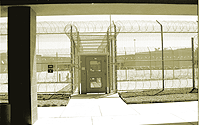 But critics of the nationwide corrections' trend toward long-term
lockdown say these environments create a self-fulfilling prophecy,
and in the end, may be psychologically harmful to prisoners and
eventually, the public.
But critics of the nationwide corrections' trend toward long-term
lockdown say these environments create a self-fulfilling prophecy,
and in the end, may be psychologically harmful to prisoners and
eventually, the public.
"What happens is [officials] give up on trying to deal with
prisoners, many of whom have serious mental health problems,"
says attorney Alvin Bronstein, director emeritus of the National
Prison Project of the American Civil Liberties Union. The number
of mentally ill inmates in state and federal prisons burgeoned
during and after the Reagan years when government funding for
the mentally ill was cut.
"You're just creating monsters," says Bronstein of
the 24-hour lockdown policy. "When they come out, they're
going to be so dangerous and so hostile and so out of touch with
reality that they're like walking time bombs."
Prisoners inside SMU II are divorced from natural light except
for the three hours a week spent alone in a narrow, concrete recreation
pen; the light defracts in from the outside through a metal covering.
Those who refuse "rec" have no indicator of the seasons.
"It's difficult to hear thunder in there," says former
inmate Paris Carriger, who only knew it was raining when water
ran down the wall near his cell.
A 7-watt bulb burns like a votive candle around the clock, illuminating
a cell stripped down to institutional furniture bolted to the
floor. Those inmates who cover their light to sleep in darkness
are written up and refused their next meal. Officers on 30-minute
bed checks peer through holes in the extruded metal into hundreds
of the same boxed vignettes: a mattress on a metal frame, a small
sink, a recessed light, a stool, a metal desk, a stainless steel
mirror and an open toilet at the front of the cell. Discipline
may be administered through turning off water or electricity.
While the conditions sound as if they're designed for Hannibal
Lecter, Vannelli allows that 85 percent to 90 percent of the inmates
follow the rules.
With the exception of Death Row inmates, the crime that a prisoner
is sentenced to in the courts has little to do with whether he
is transferred into SMU II, an all-male unit. Some of the most
violent criminals are model prisoners, and some of those convicted
of lesser charges--such as drug offenses, burglary or theft--might
end up in the supermax because they were violent for one reason
or another inside the prison walls, officials say. But Donna Hamm,
director of the prisoner-advocacy group Middle Ground, said that
one of her clients was sent to SMU II for a rules violation after
bringing a medallion that he received in a drug-treatment program
to visitation with his wife, whom he hadn't seen in three years.
"They saw him showing the medal...He was written up and thrown
in the hole."
Under the classification system put into place by former DOC
director Sam Lewis, three minor offenses within 90 days, such
as littering, possessing cash or failing to tuck in a shirt, may
constitute grounds for bumping up a prisoner's "institutional
risk score," in some cases landing him in nearly complete
lockdown for a minimum of six months. Within the prison's internal
disciplinary system, the full range of rights allowed a defendant
in the courts do not apply. Policy only requires a minimum of
24-hours notice from when the charge is delivered until the hearing.
If the paperwork is moved through the right channels, said Vannelli,
inmates bumped into solitary for smoking three times in the wrong
place--within a 90-day period--will end up at SMU I, the 13-year-old
supermax across the street--one of the first new-generation lockdown
units in the country. At SMU I, prisoners spend most of their
time in a cell, but there's more double bunking, less shackling,
and strip searching.
The state retains 20 beds in SMU II for the petulant juvies sent
up from the department's Minors Unit, in Tucson, for anything
from setting a cell on fire to assaulting staff. Another unit
is set aside for 120 severely mentally ill inmates. Then there's
the 80-bed Violence Control Unit, the prison within the supermax;
and the rest of the beds are for those who can't cope in the general
prison population.
Arizona officials also are locking high-profile gangbangers in
solitary. And gangbangers with links inside and outside the prison
have purportedly tried to retaliate. In late December, Phoenix
police arrested three men thought to be linked to a plot to kill
Director Stewart for his lockdown policy affecting 200 gang members
inside SMU II. Gangbangers, or Security Threat Groups, as officials
refer to them, have no option of stepping down from the supermax
into lower custody like other inmates, unless they "debrief,"
giving prison intelligence officers a satisfactory amount of inside
information on gangs. The result: gangbangers may serve the duration
of their sentence in the solitary confines of SMU II--decades
in some cases--until they're discharged on the street.
There are many prisoners in these settings being released directly
into the community in the most violently crazed states, says Stuart
Grassian, a psychiatrist on the Harvard Medical School faculty.
"We think we're getting tough on crime. We're getting tough
on ourselves. We're releasing people with no follow-up. No step-down.
Nothing. Many of these individuals are super paranoid, obsessional,
compulsive, unable to plan, to think. Wired." And even though
DOC officials say they prefer that prisoners move into lower security
units before they're released, there are no guarantees.
Consider Leroy Cropper, the inmate awaiting a murder trial in
connection with the control room stabbing of Officer Brent Lumley
inside the minimum- to medium-security Perryville prison. Cropper
had been sent to the lower custody prison just two months before
the murder. He'd spent one year in SMU II and was serving a six-year
sentence for drug offenses. One former SMU II inmate submits that
in placing a prisoner in what many consider a psychologically
inhumane lockup, "you teach him a deadly form of hate. Now
that's fine if you're going to kill him...You wouldn't pen a dog
up for five years and expect it to be friendly."
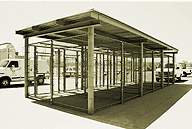 THE DIMLY LIT control room is positioned like the center
of a lotus within view of 80-some cells in the Violence Control
Unit. Glassed-in circular designs are dominating construction
on the penal cutting edge around the country.
THE DIMLY LIT control room is positioned like the center
of a lotus within view of 80-some cells in the Violence Control
Unit. Glassed-in circular designs are dominating construction
on the penal cutting edge around the country.
The surveillance runs 24 hours, with three shifts and staffing
needs for hundreds of officers. A new-hire corrections officer
presses florescent icons on the touch-screen monitor in the control
room, opening the cell for the inmate as she's directed by a line
officer down below. Two officers wearing the uniform goggles and
stab-proof jackets are escorting a cuffed prisoner; a third officer
videotapes. A control room mistake could release two inmates from
their cells at the same time, or catch an officer off guard down
on the run.
The computer system, which monitors each inmate's movement, was
considered state-of-the-art when the unit opened. But prison technology
is changing at such a meteoric pace and prices are dropping so
quickly that state prison officials now are using the same computer
system in a high-security unit in the new prison near Buckeye.
Arrington Watkins Architects, the firm which designed the unit,
along with SMU I more than 12 years ago, laid out the plan so
that with the touch of the computer screen a cell is unlocked.
Three times each week, a prisoner would walk unescorted to his
15-minute shower; on another day, he would make his weekly five-minute
collect phone call--all devoid of contact. It would be a life
of little variation and complete isolation, with the exception
of the line officer sliding three meals through the food trap
in the cell door, two hot, and the other a cold sack lunch.
"Solitary confinement has been around for a long time,"
says Craig Haney, about the practice that was used as far back
as the 1800s. "What's different about these supermax units
is that the technology of the modern correctional institution
allows for a separation, almost a technological separation, of
inmates from the social world around them in ways that really
weren't possible in the past." The new generation supermaxes
grew out of the 23-hour lockdown policy invoked at the federal
prison in Marion, Ill., in 1983.
Others like SMU I and the one in Pelican Bay, Calif., followed.
But technology has its limitations. Despite the meticulous safety
policies at SMU II, inmates have charged their cells and broken
security. Nude photographs of a female corrections officer were
found in a prisoner's cell during a shakedown; the officer resigned.
And overzealous, overworked staff sometimes move faster than the
computer program can track, resulting in the wrong doors opening.
Vannelli has moved to pin all of the cell doors with a chain welded
into place.
While the number of possibilities for what might go wrong in
the unit is limited, blood has been spilled and officers aren't
the only ones on edge. When protective segregation inmates were
at SMU II, they told their Phoenix attorney, Larry Hammond, with
the firm Osborn Maledon, about the panic they experienced in solitary
every time they heard a lock click on a cell door.
And in a federal civil lawsuit that was later dismissed, prisoners
Alvin Mumphrey and Karl Guillen wrote in affidavits that they
were both let out of their cells in G cluster, pod 6, near cell
56, in what they perceived as a set-up. One of the inmates is
noted in prison documents to have had gang affiliations. Mumphrey
wrote, "Guillen said when they let him out in the open with
me, 'It's a trick. They're trying to see if we'll kill each other
because that's what they want.' " Paranoia among inmates
in SMU II is palpable.
In the history of the unit, there have been eight inmate-on-inmate
attacks, according to DOC documents released through a state public
records request. Social psychologist Craig Haney says it's not
unusual for inmates in long-term solitary incarceration to have
intrusive thoughts: "Some of them get fixated, quite frankly,
on revenge."
And at times, "Officers are targeted because they kick-start
inmates and inmates get pissed off at them," says former
SMU II officer Janai Fraley. From the DOC incident reports, it's
difficult to say who might have been the provoker. But one recently
resigned officer said that some officers are "adamant inmate
haters."
"They just say they 'fuckin' hate inmates.' It's really
hard to explain. [There] are so many opportunities for showing
control--'You ain't getting fucking shit,' you know? 'CO, could
you sharpen my pencil?' 'No, I ain't doin' shit for you.' "
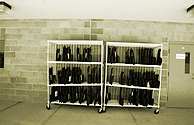 And staff occasionally get miffed at one another and use the
uncertainty of the control room as a threat. The DOC didn't release
any documents that implicated officers in instigating violence,
but one officer says she was told through an intermediary that
retribution would be doled out to her from the control room after
she turned in several co-workers for playing with the brain of
a caged prisoner. "So and so said, if I am ever an officer
in his control room, I'd better watch out." The incident
was investigated, she said. Two officers quit.
And staff occasionally get miffed at one another and use the
uncertainty of the control room as a threat. The DOC didn't release
any documents that implicated officers in instigating violence,
but one officer says she was told through an intermediary that
retribution would be doled out to her from the control room after
she turned in several co-workers for playing with the brain of
a caged prisoner. "So and so said, if I am ever an officer
in his control room, I'd better watch out." The incident
was investigated, she said. Two officers quit.
The DOC has thus far maintained a clean record in the courts
on the constitutionality of treatment and conditions in its two
supermaxes. Still, long-term solitary confinement is psychologically
unhealthy for prisoners and line officers, says the ACLU's Bronstein.
"It's sad because it institutionalizes the staff and the
prisoners. Even though the staff get out and go home at night,
spending eight or 10 hours in that kind of place is very debilitating."
THE SUMMER OF 1997 is referred to by some officers at SMU
II as "Rock and Roll." "I've seen five officers
go in with a stun plate (large plastic shield)," said a former
employee about the force used after a prisoner ignores a litany
of officer directives. "They try to get them under the chin
to knock them backwards...Each grabs an arm and leg, cuffs him
and takes him out. They have cameras going on everything...They
bring them down to medical each time."
It was during those months that inmates learned that if they
didn't cuff up, or refused to pass their trays back through the
food trap when ordered, they'd be gassed with pepper spray or
an Israeli fogger, which fills the pod with a chemical mist similar
to an insect bomb, says one former officer. The department now
sends an attack dog into the cell when the prisoner disregards
all other uses of force.
"It's not like I get pissed off at him and gas him,"
said one officer, who added that superiors were optimistic when
use of force was down. "It's always strategically planned.
A supervisor comes down...You get people suited up (in riot gear)."
Janai Fraley, a former SMU II officer, says that after repeated
gassing incidents, inmates became somewhat immune to the Israeli
fogger. "It takes more and more," she says, somewhat
incredulously. In corrections training, Fraley and other cadets
were instructed to walk through the gas without masks. "I
thought I was going to pass out, seriously," she says of
the experience. "It makes everything water so [that] you're
snotting all over yourself...It was terrifying."
Prisoners at SMU II complain about secondhand gas exposure. Several
hand-written civil cases filed against DOC officials in federal
District Court have cited the gas exposure as an infringement
of the prisoners' Eighth Amendment rights against cruel and unusual
punishment. In one such case, asthmatic inmate Johnny Davis wrote:
"Non-targeted inmates were not issued gas masks or protective
equipment such as that worn by SMU II staff. I did suffer burning
eyes and throat unable (sic) to breath (sic) and began to vomit
on my cell floor from the secondhand spray." Assistant Arizona
Attorney General Bruce Skolnik responded in the DOC's defense
that the prisoner's rights weren't violated if Davis wasn't the
intended target.
One former officer says that staff can avoid a lot of the conflict
by "just answering simple questions...You could have a major
incident over them wanting to ask you a question and you weren't
willing to listen, much less answer. They could end up banging
on their cells and you'd have to gas them. It ends up eating up
so much manpower and time, and it's not really necessary."
A number of experts in the field of solitary confinement say
inmate insubordination is often a response to isolation. "The
only interaction he has is with a guard who may or may not be
pleasant and comes to feed him [three times] a day, puts him in
chains to take him out to the yard, such that it is, for three
hours a week," says Haney, who has spent two decades studying
inmates in solitary confinement. In the last 12 years, Haney
has interviewed supermax prisoners about why they resist the rules,
given the "sometimes brutal cell extractions." His conclusion:
"It was a way of provoking human interaction...A way of reassuring
themselves that they really did exist."
Eric, a former SMU II nurse, said it took time for him to adjust
to the "violence on both sides," but he presumes it's
inevitable. "They want to show they're tougher than the officers,
and the officers can't back down...They were dragging people in
[to the nursing unit] six times a day from being gassed,"
he says of his first summer there. "I flush their eyes out
so they can see again. I wipe them off and clean them up a little
bit."
But soon it becomes routine. "You tolerate the violence.
You accept it and pretty soon it doesn't bother you anymore. It's
just another day. Some guy beat up? Took down another guy? Big
deal, they gassed another two guys today. Happens all the time."
THE CONTINUIM IN which you consider normal to mentally
ill really gets stretched after you work [in SMU II] for a while,"
recounted a recently resigned employee.
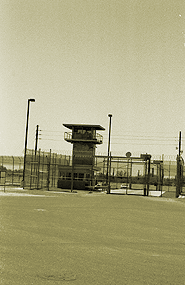 The DOC sends the system's most severely mentally ill prisoners--some
physically combative--to a unit in SMU II. "Those guys will
put it in their mouth and spit it out at you," says Eric,
who was always accompanied by two officers. "When you open
up the food trap--the stench--forget it...A lot of these guys
just don't care."
The DOC sends the system's most severely mentally ill prisoners--some
physically combative--to a unit in SMU II. "Those guys will
put it in their mouth and spit it out at you," says Eric,
who was always accompanied by two officers. "When you open
up the food trap--the stench--forget it...A lot of these guys
just don't care."
While behaviors such as sculpting figurines out of fecal matter,
masturbating in public view and gouging flesh and playing with
it are acts isolated to only a few inmates, the conduct, oddly,
is not idiosyncratic to SMU II and is seen inside supermax prisons
around the country.
One explanation for the strangely similar patterns from supermax
to supermax is that prisoners are screaming for stimulation inside
the monotony of their cells, says Stewart Grassian, who has studied
the psychiatric effects of solitary in more than 100 state and
federal prison inmates. "Certainly smearing feces on yourself
and around your cell would provide a tremendous amount of stimulation,"
he says. "A noxious amount of stimulation."
Haney adds that the behavior "requires the institution to
attend to you in an environment where people feel so desperately
ignored. Ignored as human beings."
Critics of incarcerating the mentally ill in solitary argue these
inmates are especially vulnerable to the crushing effects of isolation.
Federal Judge Thelton Henderson admonished California corrections
officials about Pelican Bay prison--at one time the national model
for high-tech security--for forcibly immersing a mentally ill
inmate into a bathtub of boiling water after he smeared feces
around his cell and bit a guard. The judge wrote that placing
mentally ill inmates in these conditions is "the mental equivalent
of putting an asthmatic in a place with little air to breathe."
As Eric made his rounds in SMU II, swabbing antiseptic on arms
extended through food traps and giving injections, inmates talked
to him. As he poured medication into their mouths from an envelope,
some prisoners complained of hallucinating. "They all wanted
to talk with you," he recalls. " 'This guy, he wants
to commit suicide,' you know, 'Go talk to him.' You've got this
guy up on the sink, and he says he's gong to dive off and land
on his head. Not too long ago, a guy hanged himself."
There have been five suicides in SMU II since the unit opened,
even with the architectural safeguard of the cell's lone towel
hook that pivots under considerable weight.
The DOC doesn't track suicide attempts or incidents of self mutilation,
says mental health Director Pamela McCauley, in part because there
are so many threats.
While 180--nearly one-fourth of the inmates in the unit--have
some type of mental health diagnosis, and 145 prisoners are on
psychiatric medications, McCauley says, "I would probably
venture to guess a large number of inmates at SMU II have a personality
disorder diagnosis of some form or another."
McCauley says that if a prisoner has urgent symptoms and requests
a visit with a professional, he's seen in 24 hours. "If it's
'I'd just like to see you guys, I don't think I'm doing as well
as I was,' the wait is 48 hours."
"There are many more threats than there are attempts,"
says McCauley, but any inmate making such a threat is put on observation.
Nonetheless, some of the most horrifying acts imaginable have
come out of SMU II. One inmate castrated himself with a "spork,"
an eating implement, and another prisoner tried to gouge his eyeball
out of its socket with a pencil.
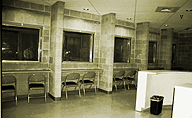 McCauley explains it this way: "If you think of the kinds
of people we're dealing with, they've manipulated their environments,
their friends and families all of their lives. It's one of the
ways, good or bad, that they've survived in the world. By the
time they've gotten to the level of SMU, we've taken away the
ability to manipulate almost everything...What they have is their
bodies.
McCauley explains it this way: "If you think of the kinds
of people we're dealing with, they've manipulated their environments,
their friends and families all of their lives. It's one of the
ways, good or bad, that they've survived in the world. By the
time they've gotten to the level of SMU, we've taken away the
ability to manipulate almost everything...What they have is their
bodies.
"The mental health staff have worked with the officers at
SMU II to show limits and how to respond to those kinds of threats
and gestures," she says, "without teaching them that
they get what they want."
McCauley cautions against any implication that solitary confinement
might push prisoners without mental illness into psychosis. "There's
a lot of interaction, even though it's mostly verbal," she
said. "People can gain a fair amount of stimulation from
reading. They can write. Watch television programs...People sit
and talk from cell to cell. They just don't see each other."
There is a paucity of controlled studies on the mental health
effects of solitary confinement. "Outside the context of
litigation, it's very difficult for scholars to get into these
places to evaluate the effects," says Haney. "The emphasis
on security has represented a bar to outside scrutiny in a way
that I think is quite problematic."
IT'S EARLY NOVEMBER and the Madison Street Jail visitors'
area in downtown Phoenix is all but deserted as pretrial detainee
Paris Carriger is summoned from his cell for a press visit. Carriger,
53, has been off Death Row at SMU II since July, awaiting a re-trial
after the Ninth U.S. Circuit Court of Appeals overturned his murder
conviction at the end of 1997. Carriger has spent more than 20
years in solitary inside the state prison and is now confined
to a wheelchair.
Despite Carriger's ability to articulate and his former habit
of communicating with "hundreds" of people on the outside,
he remains a striking embodiment of solitary institutionalization.
Eye contact is difficult. Conversation flow is mercurial. His
sense of time is shot.
"After you put that many days in a cell you loose your ability
to understand or use time," he says.
In September 1997, Death Row prisoners were swapped with protective
segregation inmates in SMU II and shuttled from Florence Prison
Cell Block 6 to the high-tech lockup. Carriger says he was traumatized
by the new environment that uses a "methodology of handling
people that absolutely denies human contact with anything except
voice."
Carriger is not a soft seed. But in CB-6, prisoners were allowed
out of their cells one hour each day, which is more common among
solitary units across the country. In CB-6, he says, the "cops"
would lock the doors after he showered so that he could "talk
trash" in front of nearby inmates' cells. Good behavior earned
time out of the cell. The isolation in SMU II proved to be such
a stress that Carriger, who used to read five books a week, did
nothing but pace his cell for 17 days.
"I would walk a long triangle across the front of the bunk,
up to the door and back on an angle," he says, bifocals propped
on his head --eyes fixed on the floor. "When I say pacing,
I mean a pace of 120 to 140 steps per minute," says Carriger,
diagnosed years ago with paranoid schizophrenia. "I don't
know if you've ever done it. Some time if you want to see what
it does to your hips, pace six feet, turn, pivot.
"It was bad enough that the counselor--at the moment I can't
remember his name--went down to property and told them to give
me my TV because I was literally going nuts."
Carriger slept little during his first month in the unit, lost
21 pounds from refusing chow, and eventually was forced back on
medication. "I would hear a young child that was apparently
locked up someplace and trying to get out," says Carriger,
who once boasted membership in the Mensa Society. "It was
bugging the piss out of me." There were occasional visual
hallucinations during his 10 months of incarceration in SMU II.
"The one that I remember offhand was watching three people
walking in and out of my house, my cell."
 The cell door was, of course, locked.
The cell door was, of course, locked.
Hallucinating is common in supermaxes, says Haney, a national
expert on the effects of sensory deprivation. "You're looking
at 30 percent with hallucinatory and perception distortions, having
a sense that the walls are closing in on you. The wall is throbbing."
Prisoners also report nervousness around people.
While it generally takes six months or more for the severe symptoms
to manifest, Haney says, some people react immediately. There
are several cases that have been dismissed in federal and county
courts in Arizona where SMU II inmates challenged the constitutionality
of the isolation and complained of "vision impairment, headaches,
memory loss," and "constant stress, anxiety, and emotional
instability." Several attorneys in Tucson and Phoenix say
their clients are suffering from symptoms ranging from depression
to complete "decompensation" since they've been transferred
to SMU II. Carla Ryan, a private Tucson attorney, has a Death
Row client who has slumped into speaking in numerals. A Pinal
County Superior Court judge ruled that Claude Maturana was incompetent
on January 15.
When Grassian conducted his research, he initially was skeptical
that prisoners would feign psychiatric symptoms. But they didn't.
It wasn't until his interviews progressed that Grassian found
that more than half of the inmates reported progressive inability
to tolerate ordinary noises; more than half described severe panic
attacks. Almost one-third of the prisoners described hearing voices,
often whispers saying frightening things to them.
Paris Carriger says it's difficult to explain the disorientation
that he felt inside SMU II. He refused recreation because he felt
uncomfortable being outside of his cell. "They twisted my
head pretty bad at SMU II," he says. "What happens is
you build up a certain pattern of a way to cope with reality as
it exists around you. When changes come, you spend time wondering
if the prison is intentionally putting you down among your enemies.
Then, you wonder if they're intentionally telling other inmates
that you're some sort of threat to them so that another inmate
might want to harm you."
THE BLAZING ARIZONA sun is bright as you walk from the
entry of SMU II into the parking lot. "I've gotten headaches
walking out of there," says former unit officer Janai Fraley,
contrasting the harsh radiance to the faintly lit control room
after working a shift inside the supermax. "I can't imagine
how those inmates feel after being incarcerated that long, and
a lot of them don't take recreation because they don't care anymore."
Carriger left the building for the Madison Street Jail through
the back door of SMU II. The cuffed inmate, dressed in an orange
jumpsuit, passed the intake booths where he had entered the building
10 months earlier, had spread his arms and legs like a starfish
for an electronic shakedown, then stripped naked for a contraband
and tattoo inspection.
Out in the sunlight, which he referred to as "painful,"
the pale Carriger waited inside a metal cage, "a glorified
dog pen," he says, for the one-hour ride to the Phoenix jail.
He had hopes that he would be acquitted in his January re-trial
and never return to SMU II. Instead, he would agree to a plea
bargain on a lesser charge: robbery and second-degree murder,
and would be sentenced to the 21 years he'd already served.
The Death Row inmate would walk free.
After decades in solitary--the last months in SMU II--how would
Carriger handle freedom? "I'm so unable to deal with communication
that most of the normal reactions like looking directly into people's
eyes bothers me," he said before his release. "My responses
are so out of tune and quite frankly, broken, that I don't see
a successful reintegration into society. As it is, I'm going to
live with family. They bought 200 acres of unimproved land. I
suspect I'll spend most of my time in the woods with a dog. It's
the only way I can survive."

|





